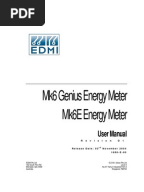Edmi Eziview Software
Posted By admin On 04/04/19. EDMI is engaged in the design, manufacture and sale of electronic revenue meters, mainly for use by utility companies involved in the generation, distribution and supply of electricity. The company was founded when John Flood and Neil Gibson, then electrical engineers with the Southern Electricity Authority of Queensland, Australia, established EDMIA – formerly known as Electronic Design and Manufacturing Queensland Pty Ltd. Today Flood is the company’s technical director; Gibson retired in 2001. The foray into electronic revenue meters began in 1990, when EDMIA won a contract from the State Electricity Commission of Victoria to develop an electronic revenue meter according to their specifications.
This first meter was named the Mark 1. In 1994 EDMIA was awarded another contract by Sydney Electricity (now known as Energy Australia) to design and manufacture an electronic revenue meter, which led to the development of the Mark 2. MEETING INTERNATIONAL STANDARDS Having recognised the potential of electronic revenue meters, EDMIA embarked on the development of its first electronic meter targeted to meet the general requirements of the market in 1995. The Mark 3 meter was the company’s first electronic revenue meter designed to meet internationally recognised standards.
Edmi Eziview Software
Never before has software been built to place the user in a position to see the impact that design changes have on the overall construction process.
Edmi Eziview Software Download
The Mark 6 followed in 1996. It was designed as a more generic electronic revenue meter targeted at a broader market segment. That same year EDMIA expanded its sales of electronic revenue meters to overseas markets, with sales to customers in the People’s Republic of China and Malaysia.
Shortly thereafter the company took advantage of the lower production costs in Singapore and established a 2,500 sq. Factory-cum-office in Senoko. Today the company operates from larger facilities – production capacity has increased by 230%, from 20,000 revenue meters per year in 2000 to 66,000 per year in 2002. Its latest model, the Mark 10, will be launched in 2004. METERING PYRAMID The use of EDMI’s meters in the electricity utilities industry is shown in Figure 1. Participants in the higher rungs of the metering pyramid typically transmit large amounts of electricity, and therefore require revenue meters with higher accuracy such as Class 0.2 or Class 0.5. Hama racing wheel thunder v5 driver. They also call for meters with more features, such as power quality measurement and communication abilities.

The volume of meters used increases towards the lower rungs of the pyramid, as the number of participants increases. EDMI’s meters are type tested to conform to IEC standards for aspects such as electromagnetic compatibility, metering accuracy and safety in electrical and electronic products. Meter designs are based on specialised microprocessors, which allow information on consumer usage patterns and power quality characteristics to be obtained through the use of proprietary operating systems. Customers are also able to download EDMI’s proprietary software programmes and scripts for easy meter reconfiguration. The scripts allow customers to incorporate changes in tariff structures, or configure the meter to perform new functions. They are written using EDMI’s proprietary Windows-based software, EziView, which is also used as an interface for its meters.
EDMI’s meters feature a range of communication options such as computer modems, fibre optics connectivity and GPRS for automatic meter reading. AMR allows utilities to obtain frequent and accurate meter readings at a reduced cost and with improved efficiency. In addition, utilities are able to build databases to assist with analysis and forecasts, thanks to the regular flow of information on their consumers’ usage patterns and power quality characteristics. MOD CENTRES FOR CUSTOMER SERVICE EDMI established the concept of mod centres in 2002. These mod (or modification) centres are where the company calibrates, customises and repairs its meters for improved customer service. Two centres have been established, in Australia and Malaysia. They are also used to establish contacts and to showcase the company’s meters to prospective customers.
Eziview Software
INITIAL PUBLIC OFFERING LAUNCHED In October 2003 EDMI launched its Initial Public Offering (IPO) as the first step towards listing on the Singapore Stock Exchange SGX SESDAQ. The invitation is in respect of 59,400,000 ordinary shares of five cents each at an issue price of 26 cents per share, comprising 37,600,000 new shares and 21,800,000 vendor shares. Of the 59,400,000 invitation shares, 6 million will be offered to the public. The remaining shares are placement shares, including 13 million reserved shares for directors and employees of the EDMI Group and related corporations, business associates and those who have contributed to the group’s success.
Based on the issue price of 26 cents and FY2002 historical earnings per share of 2.59 cents, the shares are priced at a historical price:earnings ratio of ten times. EDMI will have a market capitalisation of $48.9 million upon listing, and will be the first metering company listed on the SGX. Managing director Lee Kwang Mong says: “We are a niche player in the global market for microprocessor-based electronic revenue meters. EDMI’s listing on a globally respected stock market such as the SGX will enhance its standing and credibility. This will help establish a strong corporate identity for EDMI, while facilitating our expansion to new markets across Europe and the Middle East.” Today the EDMI Group manufactures its meters in Singapore and conducts its research and development activities out of Australia.
EDMI meters have been installed in over 14 countries across ASEAN, Asia, Australasia and Europe. Net proceeds from the issue of the shares will be used for the production, launch and marketing of the new Mark 10 meter; to expand the group’s geographical network of appointed sales agents and mod centres; and to strengthen the group’s R&D capabilities. “Electricity consumption will continue on the up trend in both developed and developing economies,” says Lee. “This is driven by growth in population and economic development, industries shifting from labour-intensive to capital-intensive processes utilising automated machinery, and our modern lifestyles, all of which require more electricity.

“The growth of the electric utilities industry, coupled with increased deregulation and technological advancements, would tend to accelerate the replacement of traditional electromechanical revenue meters with electronic revenue meters, such as those produced by EDMI. The use of technology in our meters, backed by our commitment to customer support, are the main reasons why we are able to compete against our European competitors.”.
